Many private equity firms were caught out by interest rate hikes in 2022 after snapping up lower-rated businesses during the easy money era using floating-rate debt. Those firms are typically more highly leveraged than their public equivalents making them more vulnerable to distress. PE-owned companies accounted for three out of five bankruptcies filed during the second quarter: Ascend Performance Materials Operations LLC, At Home Group Inc and CareerBuilder LLC.
Some lower-rated issuers, which were already facing heightened credit risk, were compelled to restructure or renegotiate their debt, mostly through distressed exchanges, a trend that’s expected to continue in the third quarter. About three in four of the exchanges involved PE portfolio firms.
For privately-owned companies, weak liquidity is one of the major risks, according to the report.
“If the market becomes volatile they won’t be able to access liquidity they need,” Julia Chursin, vice president and senior analyst at Moody’s, said of these companies. “They will unlikely be able to refinance their debt.”
See also: National University of Singapore to sell US$500 million in PE and real estate funds: Bloomberg
The loan market bore the brunt of the distress, as many businesses backed by PE firms have capital structures only made up of loans. The default rate for loans was 6.6% at the end of June, compared to 4.2% for high-yield bonds, according to Moody’s.
“The problem with loan-only debt structures is that these loans have a floating rate,” Chursin said. “If there is a widening of the spread they have to do an out-of-court restructuring.”
Junk-rated telecommunications provider Radiate HoldCo LLC, owned by Stonepeak Partners and TPG Inc, marked the quarter’s largest default, affecting US$3.8 billion of loans and US$1.9 billion of notes. The company launched a distressed exchange to address its outstanding debt maturing between 2025 and 2028.
See also: Private credit on defensive again over ‘mark-to-myth’ study
Companies typically propose distressed exchanges — a kind of restructuring agreement — to improve liquidity, reduce liabilities, manage upcoming debt maturities and ultimately avoid bankruptcy. These exchanges made up the majority of defaults at 13 companies tied to US$20 billion of loans and bonds. Several companies, including Community Health Systems and All Day Acquisition LLC, had tapped out-of-restructurings before.
“Distressed exchanges are idiosyncratic, they are harder to predict and do not work most of the time,” Chursin said. “There is a 50/50 chance of filing for bankruptcy. We call it, ‘kicking the default can down the road.’”
The recovery rate when loans restructure is falling as distressed exchanges become increasingly complex and some companies re-default. Over the last four years, lenders got back an average of 61% of the principal on first-lien loans for this type of debt compared with a historical average of 73%, according to separate report published by Moody’s in April.
Moody’s predicts that the durables sector, which includes appliances and automobiles, will make up the majority of defaults in the next year, in part due to tariff pressure. But regardless of the sector, low-rated businesses “remain highly susceptible to tariff-related risks,” according to the report.




